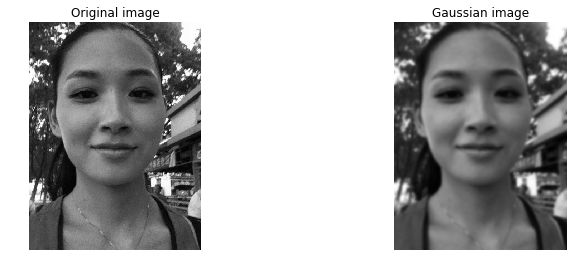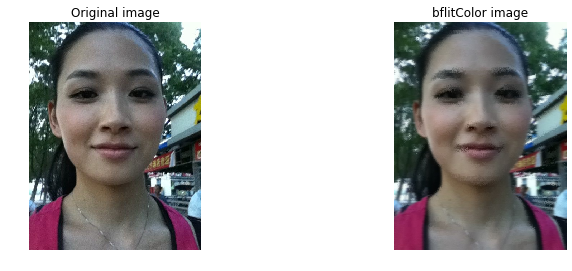import numpy as np
from scipy.misc import imread
import matplotlib.pyplot as plt
%matplotlib inline
plt.rcParams['figure.figsize'] = (12.0, 9.0) # set default size of plots
plt.rcParams['image.interpolation'] = 'nearest'
plt.rcParams['image.cmap'] = 'gray'def imshow_noax(img, normalize=True):
""" Tiny helper to show images as uint8 and remove axis labels """
if normalize:
img_max, img_min = np.max(img), np.min(img)
img = 255.0 * (img - img_min) / (img_max - img_min)
plt.imshow(img.astype('uint8'))
plt.gca().axis('off')高斯滤波
在进行数学仿真或者误差评估时,往往认为传感器所引入的噪声服从正态分布(高斯白噪声)。为了消除这些噪声,引入了高斯滤波。其滤波的思路:对高斯函数进行离散化,以离散点上的高斯函数值为权值,对信号做一定范围邻域内的加权平均。对于图像(灰度矩阵),我们采用二维高斯滤波滤除去图像的高斯噪声。
σ 越大,高斯滤波的频带越宽,平滑程度高。
高斯滤波器的工作原理是用像素领域的加权值来代替该点的像素值。而每一领域像素点权值是随该点与中心点的距离单调增减的。
D为高斯核的维度。在opencv与sift中的源码中, D=1+2∗(int)(3.0∗σ) ,因为在 i(j)∈[i(j)−3σ,i(j)+3σ] 的概率大于99%,所以高斯核的大小与sigma的取值有关。实际上,高斯核大小也可以手动选择,并没有严格的要求。在代码中,我们引入”truncate“作为高斯核大小的缩放因子,并将高斯核归一化。
def gaussian_kernel(sigma, truncate=3.0):
"""
Return Gaussian that truncates at the given number of standard deviations.
"""
sigma = float(sigma)
radius = int(truncate * sigma + 0.5)
x, y = np.mgrid[-radius:radius+1, -radius:radius+1]
sigma = sigma**2
G = np.exp(-0.5 * (np.power(x, 2) + np.power(y, 2)) / sigma)
G = G / np.sum(G)
return Gdef convolve(src, F):
H, W = src.shape
HH, WW = F.shape
assert(H > HH)
assert(W > WW)
hh = HH / 2
ww = WW / 2
dst = np.zeros((H, W))
src_pad = np.pad(src, (hh, ww), 'symmetric')
for i in range(H):
for j in range(W):
overlap = src_pad[i : i + HH, j: j + WW]
average = np.sum(F * overlap)
dst[i, j] = average
return dst二维高斯函数卷积的另一种方法:分两步来进行,首先将图像与一维高斯函数进行卷积,然后将卷积结果与方向垂直的相同一维高斯函数卷积。因此,高斯滤波的计算量随滤波模板宽度成线性增长而不是成平方增长。
# 灰度图
img = imread('test.jpg', flatten=True)
f= gaussian_kernel(3)
dst = convolve(img, f)
plt.subplot(2, 2, 1)
imshow_noax(img, normalize=False)
plt.title('Original image')
plt.subplot(2, 2, 2)
imshow_noax(dst, normalize=False)
plt.title('Gaussian image')<matplotlib.text.Text at 0x7f0310613dd0>
双边滤波
双边滤波(Bilateral filter)是一种可以保边去噪的滤波器。之所以可以达到此去噪效果,是因为滤波器是由两个函数构成。一个函数是由几何空间距离决定滤波器系数。另一个由像素差值决定滤波器系数。可以与其相比较的两个filter:高斯低通滤波器(http://en.wikipedia.org/wiki/Gaussian_filter)和α-截尾均值滤波器(去掉百分率为α的最小值和最大之后剩下像素的均值作为滤波器),后文中将结合公式做详细介绍。
def bflitGray(img, sigma_d, sigma_r):
H, W = img.shape
sigma_d = float(sigma_d)
radius = int(3.0 * sigma_d + 0.5)
R = 2 * radius + 1
dst = np.zeros((H, W))
img_pad = np.pad(img, (radius, radius), 'symmetric')
x, y = np.mgrid[-radius: radius+1, -radius: radius+1]
G = np.exp(-0.5 * (np.power(x, 2) + np.power(y, 2)) / sigma_d**2)
G = G / np.sum(G)
for i in range(H):
for j in range(W):
overlap = img_pad[i : i + R, j: j + R]
A = img[i, j]
H = np.exp(-0.5 * np.power((overlap - A), 2) / sigma_r**2)
F = np.dot(H, G)
F = F / np.sum(F)
dst[i, j] = np.sum(F * overlap)
return dst def bflitColor(img, sigma_d, sigma_r):
H, W, C = img.shape
sigma_d = float(sigma_d)
radius = int(3.0 * sigma_d + 0.5)
R = 2 * radius + 1
dst = np.zeros((H, W, C))
img_pad = np.pad(img, ((radius, radius), (radius, radius), (0, 0)), 'symmetric')
x, y = np.mgrid[-radius: radius+1, -radius: radius+1]
G = np.exp(-0.5 * (np.power(x, 2) + np.power(y, 2)) / sigma_d**2)
G = G / np.sum(G)
F = np.zeros(3)
for i in range(H):
for j in range(W):
overlap = img_pad[i : i + R, j: j + R, :]
A = img[i, j, :]
I0 = np.power(overlap[:, :, 0] - A[0], 2)
I1 = np.power(overlap[:, :, 1] - A[1], 2)
I2 = np.power(overlap[:, :, 2] - A[2], 2)
H = np.exp(-0.5 * (I0 + I1 + I2) / sigma_r**2)
F = np.dot(H, G)
F = F / np.sum(F)
dst[i, j, 0] = np.sum(F * overlap[:, :, 0])
dst[i, j, 1] = np.sum(F * overlap[:, :, 1])
dst[i, j, 2] = np.sum(F * overlap[:, :, 2])
return dstimgColor = imread('test.jpg')
dstColor = bflitColor(imgColor, 3, 0.3)
plt.subplot(2, 2, 1)
imshow_noax(imgColor, normalize=False)
plt.title('Original image')
plt.subplot(2, 2, 2)
imshow_noax(dstColor, normalize=False)
plt.title('bflitColor image')Skin Detection
基于RGB颜色空间的简单阈值肤色识别
在RGB色域里,皮肤满足如下关系式
R>95 && G>40 && B>20 && R>G && R>B && Max(R,G,B)- Min(R,G,B)>15 Abs(R-G)>15 $$
另外还有其他基于YUV, YCbC等色彩空间的肤色检测,但都效果不佳(包括RGB, 例图:尽可能阐释算法的优点的图片)。
参考:Human skin color clustering for face detection
def skin_detect_with_rgb(image):
R = image[:, :, 0]
G = image[:, :, 1]
B = image[:, :, 2]
R = np.where(R > 95, R, 0)
G = np.where(G > 40, G, 0)
B = np.where(B > 20, B, 0)
R = np.where(R > G, R, 0)
R = np.where(R > B, R, 0)
G = np.where(R > 0, G, 0)
B = np.where(R > 0, B, 0)
RG = np.abs(R - G)
R = np.where(RG > 15, R, 0)
G = np.where(R > 0, G, 0)
B = np.where(R > 0, B, 0)
img_mask = np.zeros(image.shape)
img_mask[:, :, 0] = R
img_mask[:, :, 1] = G
img_mask[:, :, 2] = B
return img_maskimgColor = imread('test.png')
imgSkin = skin_detect_with_rgb(imgColor)
imgBinary = np.where(imgSkin > 0, 255, 0)
plt.subplot(2, 3, 1)
imshow_noax(imgColor, normalize=False)
plt.title('Original image')
plt.subplot(2, 3, 2)
imshow_noax(imgSkin, normalize=False)
plt.title('Skin image')
plt.subplot(2, 3, 3)
imshow_noax(imgBinary, normalize=False)
plt.title('Binary image')<matplotlib.text.Text at 0x7f030c51e990>
磨皮是图像滤波的一个实际应用。比较常见滤波有中值滤波,均值滤波,高斯滤波,双边滤波。其中双边滤波对图像边缘保护较好,而且有相应的加速方法Real-Time O(1) Bilateral Filtering, 在美颜中有相当广泛的应用。当然例如导向滤波, on-Local以及BM3D等能保留边缘细节的滤波算法都可以作为磨皮的滤波算法。
保护好非皮肤区域,尤其是眼睛。肤色检测易受外界的影响,肤色检测结果往往会包含嘴唇、牙齿等细节部位,对整张图片质量影响较大。学好DL有助于图像处理,哈哈哈哈。
一个 Github 链接: SkinSmoothing
一个国内网站:微像素
注:图片来源与网络。

























 3545
3545

 被折叠的 条评论
为什么被折叠?
被折叠的 条评论
为什么被折叠?








